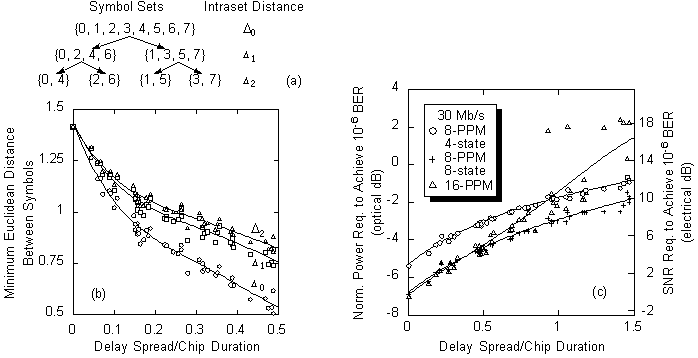
Modulation for Wireless Infrared
Contributed by J.M. Kahn
For transmission over infrared channels Intensity modulation with direct detection (IM/DD) represents the only viable means of modulating and demodulating the optical carrier, because of spatially incoherent propagation.
Modulation and Demodulation Techniques
The most important factor governing the choice of an intensity-modulation technique is the average power efficiency, since average power governs the eye safety and power consumption of an infrared transmitter. In non-directed links, one must consider the average power required in the presence of multipath-induced ISI. Another important factor is the signal-processing complexity required to decode the received signal. For a given bit rate, this complexity is generally much lower for an infrared link than for a radio link. For example, it has been demonstrated possible to mitigate multipath ISI in a 50-Mb/s diffuse infrared link using only a simple decision-feedback equalizer (DFE) having three feedback taps.
While bandwidth efficiency at the carrier frequency is of paramount importance in radio systems, it is not very important in infrared systems, because would be very difficult to perform dense optical-domain frequency-division multiplexing in IM/DD infrared systems. Much of the research to date has sought to devise power-efficient modulation/demodulation techniques, and will be described below.
Modulation and Detection Techniques for Multipath Infrared Channels
Good modulation/demodulation techniques should yield high average power efficiency on non-directed infrared channels, which are subject to multipath ISI.
Pulse-position modulation (PPM) is well-known to provide high average-power efficiency, but because it utilizes shorter pulses, it is more susceptible to ISI than on-off keying (OOK).
An optimum maximum-likelihood sequence detector (MLSD) for PPM permits the achievement of very low bit-error rates (BERs) when the ISI would lead to a high irreducible BER without equalization.
The optimum MLSD might be excessively complex to implement in some applications, so a much simpler adaptive decision-feedback equalizers (DFEs) may be more practical.
Both DFEs provide performance benefits that are close to those of MLSD.
While these techniques prevent the occurrence of irreducible BERs in PPM systems, they are not as effective in reducing multipath power penalties as are corresponding techniques for OOK, especially when the ISI is severe (e.g., on shadowed channels at bit rates of 30Mb/s and higher).

Figure:
Left-upper: Set partitioning for 8-PPM.
Left_Lower: Minimum Euclidean distance between 8-PPM symbols on various measured ISI channels vs. the channel delay spread divided by the PPM chip duration.
Right:
Normalized optical average-power requirement vs. delay spread divided by chip duration for 30-Mb/s systems employing 8PPM with rate 2/3 TCM and uncoded 16PPM
A note on theoretical analysis:
Theoretical performance analysis of the DFE detector is more difficult than for MLSD. One method is to
comprise the L-PPM signal set of a set of L different symbols, each comprised of L chips, of which only one chip is non-zero. One can consider DFEs that make chip-by-chip decisions, feeding them back to cancel both intra- and inter-symbol interference, as well as those that make symbol-by-symbol decisions using a minimum-Euclidean-distance detector, using these decisions to cancel only inter-symbol interference.
Trellis Coded Modulation
A much more effective technique is to combine trellis-coded modulation (TCM) with PPM. TCM combines convolutional coding with a mapping of coded sequences to symbols based on set partitioning. Set partitioning divides the signal set into subsets having progressively larger minimum Euclidean distance. This is normally not useful with orthogonal modulations, such as PPM, since all symbols are equidistant. However, we observe that ISI tends to reduce the distance between symbols whose non-zero chips lie nearby in time more than it does between symbols whose non-zero chips are well-separated.
For 8-PPM set partitioning in conjunction with 8-PSK trellis codes, MLSD yields up to a 4-dB improvement in optical power efficiency over uncoded 16-PPM with MLSD. This makes PPM with TCM the most power-efficient modulation scheme known to date for ISI channels.
Multi-Carrier
Multiple-subcarrier modulation (MSM) is a technique that enables flexible, asynchronous frequency-division multiplexing, while maintaining the simplicity of IM/DD. For achieving a link capacity of 100 Mb/s, a typical transmission format might consist of five 10-Mbaud quadriphase-shift-keyed subcarriers placed at subcarrier frequencies of 10, 30, 50, 70 and 90 MHz. MSM uses narrowband signals, and hence avoids the ISI penalty experienced by high symbol-rate transmission through the multipath channel. While avoiding the ISI penalty, MSM with IM/DD incurs another power penalty. Because optical intensity cannot take on negative values, a large d.c. bias must be added to the transmitter drive signal, resulting of power penalties of several dB with respect to baseband OOK. While MSM is not as power-efficient as OOK or PPM, it appears that it can permit transmission at bit rates as high as 100Mb/s without equalization.





